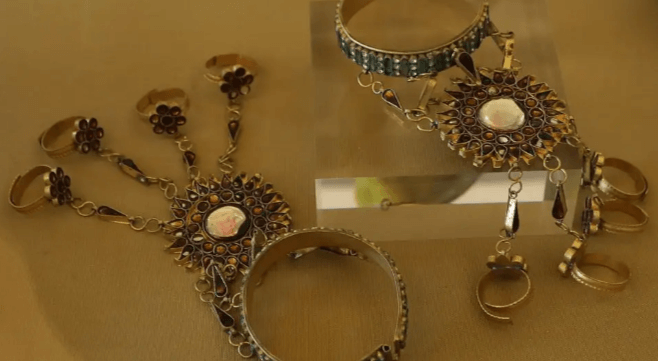The Roaring Twenties in Gems: A Look Back at 1920s Jewellery

The 1920s, famously dubbed as “The Roaring Twenties,” marked a period of unprecedented social and cultural change, accompanied by economic prosperity and artistic innovation. One of the most captivating aspects of this era was its Jewellery trends, reflecting the spirit of exuberance and liberation. Let’s delve into the captivating world of 1920s Jewellery, exploring its styles, materials, cultural influences, celebrity endorsements, and enduring legacy.
Art Deco: The Dominant Style
- Bold geometric shapes: Jewellery designs of the 1920s embraced geometric patterns, featuring squares, triangles, and circles, influenced by the Art Deco movement.
- Symmetry and symmetry: Symmetry was a hallmark of Art Deco Jewellery, with precise lines and balanced compositions reflecting the modernist aesthetic of the era.
- Precious metals and gemstones: Platinum, white gold, and silver were favored metals for Art Deco Jewellery, often adorned with diamonds, emeralds, sapphires, and rubies, creating striking contrasts against the metal backdrop.
Flapper Fashion: Iconic Jewellery Trends
- Long necklaces: Flappers, symbolic of the newfound freedom and rebellion of women, popularized long pearl necklaces, often worn in layers or with tassels, accentuating the sleek silhouette of the era’s fashion.
- Tassel earrings: Earrings adorned with tassels or fringe elements added movement and dynamism to the wearer’s look, complementing the spirited atmosphere of the Jazz Age.
- Headpieces and hair ornaments: Decorative headbands, tiaras, and hair combs embellished with pearls, rhinestones, and feathers adorned the coiffures of fashionable women, evoking a sense of glamour and opulence.
Cultural Influences: Exoticism and Revivals
- Orientalism: The allure of the East captivated designers, leading to the incorporation of Asian motifs and techniques in Jewellery, including jade carvings, cloisonné enameling, and lacquerwork, reflecting a fascination with Eastern culture and aesthetics.
- Modernist influences: The avant-garde artistic movements of the early 20th century, such as Cubism and Futurism, influenced Jewellery design, resulting in abstract and unconventional forms that challenged traditional notions of beauty and craftsmanship.
Celebrity Endorsements: Shaping Trends
- Iconic figures: Celebrities and socialites of the 1920s, including Coco Chanel, Josephine Baker, and Zelda Fitzgerald, played a pivotal role in popularizing specific Jewellery styles and setting fashion trends through their public appearances and endorsements.
- Influence of Hollywood: The burgeoning film industry contributed to the dissemination of glamorous imagery and aspirational lifestyles, with movie stars like Greta Garbo and Joan Crawford showcasing lavish Jewellery on the silver screen, inspiring audiences worldwide.
Legacy and Contemporary Revivals
- Enduring appeal: The allure of 1920s Jewellery continues to captivate contemporary audiences, with Art Deco-inspired designs enduring as a timeless expression of sophistication and glamour.
- Revival in fashion: Fashion designers and Jewellery houses frequently draw inspiration from the Roaring Twenties, reinterpreting its iconic motifs and styles for modern sensibilities, ensuring that the legacy of 1920s Jewellery remains vibrant and relevant in the 21st century.
The Role of Technological Advancements
Machine Age Aesthetics: The industrial advances of the Machine Age played a pivotal role in shaping the streamlined and mechanical aesthetic of Art Deco Jewellery. Techniques like die-casting and electroplating allowed for intricate designs to be replicated quickly and efficiently, reducing costs and making elaborate pieces available to the middle class.
Introduction of Bakelite: One of the most significant technological advancements was the introduction of Bakelite, an early form of plastic. This material revolutionized Jewellery by allowing for bold, vibrant colors and intricate shapes that were previously difficult or impossible to achieve with traditional materials. Bakelite bangles, brooches, and beads became hugely popular, offering an affordable alternative to precious gems and metals.
Gender and Jewellery: Breaking Traditional Norms
The Roaring Twenties were a time of significant social change, particularly in the roles and expectations of women. This shift was reflected in the Jewellery trends of the era, which often broke with traditional gender norms.
Empowerment through Accessories: Jewellery became a powerful tool for women to express their newfound independence and assertiveness. The bold, oversized designs of cocktail rings and long, dangling earrings made strong statements, contrasting with the more delicate and conservative Jewellery of previous eras.
Unisex Designs: The blurring of gender lines was also evident in the emergence of unisex Jewellery. Items such as cufflinks, tie clips, and lapel pins, which were traditionally considered men’s accessories, began to be adopted by women, reflecting the broader societal shift towards gender equality and fluidity.
Regional Variations and Global Influence
European Elegance: In Europe, particularly in France, Jewellery houses like Cartier and Van Cleef & Arpels led the way in combining traditional craftsmanship with modern designs. Their pieces often featured intricate settings and high-quality gemstones, maintaining a level of elegance and sophistication that appealed to the elite.
American Innovation: In the United States, the focus was more on innovation and accessibility. American designers experimented with new materials and techniques, producing pieces that were both stylish and affordable, catering to the growing middle class.
Asian Artistry: The fascination with Asian art and culture led to the incorporation of Eastern motifs and techniques in Western Jewellery. Japanese lacquerwork, Chinese jade carvings, and Indian enamel techniques were integrated into contemporary designs, creating unique pieces that celebrated the fusion of different cultural elements.
Conclusion
The Jewellery of the Roaring Twenties embodies the spirit of an era marked by cultural dynamism, artistic innovation, and social liberation. From the geometric elegance of Art Deco to the exoticism of Egyptian motifs, 1920s Jewellery reflects the zeitgeist of a transformative period in history. As we continue to look back at this fascinating era, its influence on fashion and design endures, reminding us of the enduring allure of the Jazz Age.
Whether through vintage pieces or contemporary interpretations, the legacy of 1920s Jewellery continues to sparkle and shine, captivating generations with its timeless elegance and unparalleled glamour.






